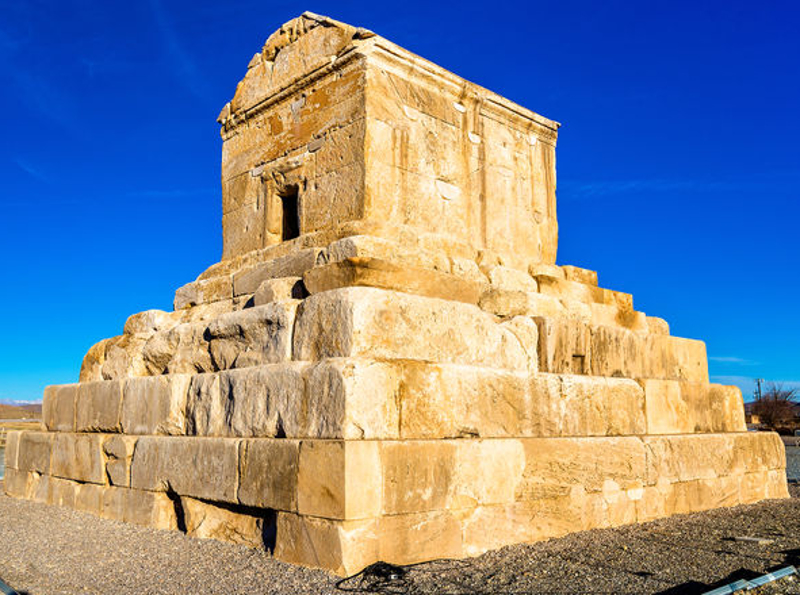My Journey to The Persian Empire
Cyrus Tomb is regarded as one of the most significant monuments at Pasargadae. After Cyrus the Great's death in 530 BCE, this tomb was used as his burial site. The tomb is not elaborate, but instead is rather simple. It is the size of a small house and is positioned on a raised, stepped plinth. In light of this burial, some questions have been raised regarding the religion of Cyrus and other Achaemenid kings. The practice of burying the dead in a tomb was untoward to Zoroastrians later on, who regarded it as sacrilege to pollute the earth with dead bodies. Instead, they left the dead-on towers of silence exposed to the elements for birds and animals to consume. Scholars have suggested that perhaps an earlier, pre-Zoroastrian tradition of burial may still have existed back at that time (Axworthy 2008).
The tomb's upper part is composed of two chambers: the real tomb which is a square room and an attic. However, it is not known what this second room is used for. The Tomb chamber measures three meters in width, two meters in height, and two meters in depth. It contained Cyrus' arms, his jewelry, and a cloak, in addition to the gold sarcophagus. The cloak played a significant role in the Persian inauguration ceremony (Lendering:Pasargadae).
Historically, the Cyrus Tomb is of great importance, as it is the burial place of the founder of the Persian Empire, which at the time was one of the most powerful empires in history.
According to Plutarch, there was also an inscription on Cyrus' tomb that stated, "I am Cyrus, and I won for the Persians their empire. Do not, therefore, begrudge me this little earth which covers my body.". As the Plutarch stated, “These words, then, deeply affected Alexander, who was reminded of the uncertainty and mutability of life.” (Plutarch:Alexander).
In my travels through time, I would visit this tomb at the time that Cyrus would be buried in it. Why? it is simple. In this day and age, with dictators and despots building elaborate tombs to commemorate their rule, no matter how unsavory they were or how badly they treated their subjects, today, some 2500 years after burial, there survives a simple tomb, with little ostentation, dedicated to a great man. The message: it is the deeds of great men who survive through the ages, not the size or ostentation of their burial place.
Anahita Salehkhou
6 chapters
25 Jun 2022
The Tomb of Cyrus The Great
Persia
Cyrus Tomb is regarded as one of the most significant monuments at Pasargadae. After Cyrus the Great's death in 530 BCE, this tomb was used as his burial site. The tomb is not elaborate, but instead is rather simple. It is the size of a small house and is positioned on a raised, stepped plinth. In light of this burial, some questions have been raised regarding the religion of Cyrus and other Achaemenid kings. The practice of burying the dead in a tomb was untoward to Zoroastrians later on, who regarded it as sacrilege to pollute the earth with dead bodies. Instead, they left the dead-on towers of silence exposed to the elements for birds and animals to consume. Scholars have suggested that perhaps an earlier, pre-Zoroastrian tradition of burial may still have existed back at that time (Axworthy 2008).
The tomb's upper part is composed of two chambers: the real tomb which is a square room and an attic. However, it is not known what this second room is used for. The Tomb chamber measures three meters in width, two meters in height, and two meters in depth. It contained Cyrus' arms, his jewelry, and a cloak, in addition to the gold sarcophagus. The cloak played a significant role in the Persian inauguration ceremony (Lendering:Pasargadae).
Historically, the Cyrus Tomb is of great importance, as it is the burial place of the founder of the Persian Empire, which at the time was one of the most powerful empires in history.
According to Plutarch, there was also an inscription on Cyrus' tomb that stated, "I am Cyrus, and I won for the Persians their empire. Do not, therefore, begrudge me this little earth which covers my body.". As the Plutarch stated, “These words, then, deeply affected Alexander, who was reminded of the uncertainty and mutability of life.” (Plutarch:Alexander).
In my travels through time, I would visit this tomb at the time that Cyrus would be buried in it. Why? it is simple. In this day and age, with dictators and despots building elaborate tombs to commemorate their rule, no matter how unsavory they were or how badly they treated their subjects, today, some 2500 years after burial, there survives a simple tomb, with little ostentation, dedicated to a great man. The message: it is the deeds of great men who survive through the ages, not the size or ostentation of their burial place.

The tomb of Cyrus the Great at Pasargadae
Leonid Andronov. The tomb of Cyrus the Great at Pasargadae.Photograph.Shutterstock.com
Share your travel adventures like this!
Create your own travel blog in one step
Share with friends and family to follow your journey
Easy set up, no technical knowledge needed and unlimited storage!